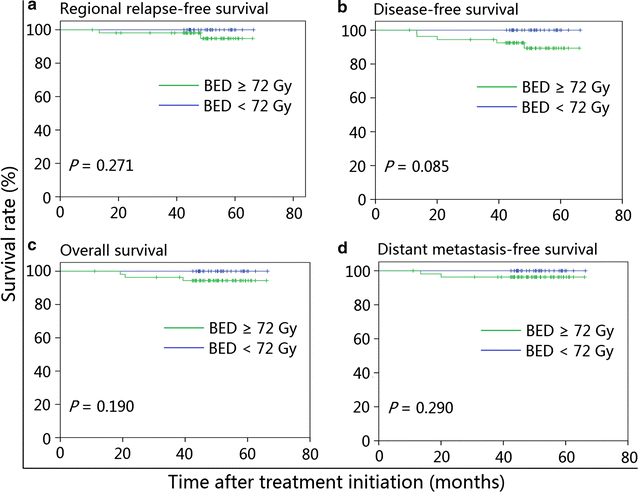Clinical treatment considerations in the intensity-modulated radiotherapy era for patients with N0-category nasopharyngeal carcinoma and enlarged neck lymph nodes
- PMID: 28340596
- PMCID: PMC5364609
- DOI: 10.1186/s40880-017-0199-2
Clinical treatment considerations in the intensity-modulated radiotherapy era for patients with N0-category nasopharyngeal carcinoma and enlarged neck lymph nodes
Abstract
Background: Nasopharyngeal carcinoma (NPC) shows a high proportion of lymph node metastasis, and treatment guidelines have been developed for positive nodes. However, no irradiation guidelines have been proposed for patients with enlarged neck lymph nodes (ENLNs) that do not meet the radiological criteria of 10 mm in diameter for positive lymph nodes. This study aimed to determine the prognostic value and radiation dose for ENLNs in N0-category NPC patients treated with intensity-modulated radiotherapy (IMRT).
Methods: We reviewed the medical data of 251 patients with non-metastatic, N0-category NPC treated with IMRT. Receiver operating characteristic curves were used to calculate the cut-off value of the ENLN diameter for the prediction of disease failure. The biological equivalent dose (BED) for ENLNs was calculated. Patient survival was compared between the small and large ENLN groups. Independent prognostic factors were identified using the Cox proportional hazards model.
Results: The estimated 4-year regional relapse-free survival rate was higher in patients with ENLNs ≥5.5 mm than in those with ENLNs <5.5 mm (100% vs. 98.8%, P = 0.049), whereas disease-free, overall, and distant metastasis-free survival rates were similar between the two groups. After adjusting for various factors, ENLN diameter was not identified as an independent prognostic factor (P > 0.05 for all survival rates). In the subgroup analysis, patients receiving BED ≥72 Gy had a similar prognosis as patients receiving BED <72 Gy in both the small and large ENLN groups. The multivariate analysis also confirmed that BED ≥72 Gy was not associated with significantly improved prognosis in patients with N0-category NPC.
Conclusions: A BED of 72 Gy to ENLNs is considerably sufficient to provide a clinical benefit to patients with N0-category NPC. Prospective studies are warranted to validate the findings in the present study.
Keywords: Biological equivalent dose; Enlarged neck lymph node; Intensity-modulated radiotherapy; N0-category; Nasopharyngeal carcinoma; Prognosis.
Figures




Similar articles
-
Incidence of small lymph node metastases in patients with nasopharyngeal carcinoma: Clinical implications for prognosis and treatment.Head Neck. 2017 Feb;39(2):305-310. doi: 10.1002/hed.24586. Epub 2016 Sep 14. Head Neck. 2017. PMID: 27627795
-
Significant value of 18F-FDG-PET/CT in diagnosing small cervical lymph node metastases in patients with nasopharyngeal carcinoma treated with intensity-modulated radiotherapy.Chin J Cancer. 2017 Dec 19;36(1):95. doi: 10.1186/s40880-017-0265-9. Chin J Cancer. 2017. PMID: 29258597 Free PMC article.
-
[Prophylactic irradiation of cervical lymph nodes for Stage-N0 nasopharyngeal carcinoma].Chin J Cancer. 2010 Jan;29(1):106-10. doi: 10.5732/cjc.009.10297. Chin J Cancer. 2010. PMID: 20038321 Chinese.
-
Implications of quantitative tumor and nodal regression rates for nasopharyngeal carcinomas after 45 Gy of radiotherapy.Int J Radiat Oncol Biol Phys. 2001 Jul 15;50(4):961-9. doi: 10.1016/s0360-3016(01)01531-0. Int J Radiat Oncol Biol Phys. 2001. PMID: 11429224 Review.
-
Current thinking on the management of abnormal retropharyngeal nodes in patients with oral, oropharyngeal, and nasopharyngeal squamous cell carcinoma: a structured review.Br J Oral Maxillofac Surg. 2019 Jul;57(6):515-528. doi: 10.1016/j.bjoms.2019.04.017. Epub 2019 May 7. Br J Oral Maxillofac Surg. 2019. PMID: 31076218 Review.
Cited by
-
Advantage of PET/CT in Target Delineation of MRI-negative Cervical Lymph Nodes In Intensity-Modulated Radiation Therapy Planning for Nasopharyngeal Carcinoma.J Cancer. 2017 Nov 6;8(19):4117-4123. doi: 10.7150/jca.21582. eCollection 2017. J Cancer. 2017. PMID: 29187888 Free PMC article.
-
Immunohistochemical Expression and Clinical Significance of WWP1 Protein in Nasopharyngeal Cancer.J Histochem Cytochem. 2024 Jun;72(6):363-371. doi: 10.1369/00221554241255722. Epub 2024 May 28. J Histochem Cytochem. 2024. PMID: 38804681 Free PMC article.
-
Treatment Outcomes of 257 Patients with Locoregionally Advanced Nasopharyngeal Carcinoma Treated with Nimotuzumab Plus Intensity-Modulated Radiotherapy with or without Chemotherapy: A Single-Institution Experience.Transl Oncol. 2018 Feb;11(1):65-73. doi: 10.1016/j.tranon.2017.11.002. Epub 2017 Dec 5. Transl Oncol. 2018. PMID: 29202278 Free PMC article.
-
Optimal sequencing of chemotherapy with chemoradiotherapy based on TNM stage classification and EBV DNA in locoregionally advanced nasopharyngeal carcinoma.Cancer Commun (Lond). 2019 Oct 25;39(1):64. doi: 10.1186/s40880-019-0398-0. Cancer Commun (Lond). 2019. PMID: 31653270 Free PMC article. No abstract available.
-
New frontiers in proton therapy: applications in cancers.Cancer Commun (Lond). 2019 Oct 22;39(1):61. doi: 10.1186/s40880-019-0407-3. Cancer Commun (Lond). 2019. PMID: 31640788 Free PMC article. Review.
References
-
- National Comprehensive Cancer Network Clinical Practice Guidelines in Oncology, version 1.2016. http://www.nccn.org/professionals/physician_gls/f_guidelines.asp. Accessed 6 May 2016.
MeSH terms
LinkOut - more resources
Full Text Sources
Other Literature Sources

